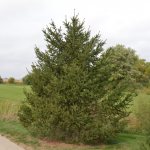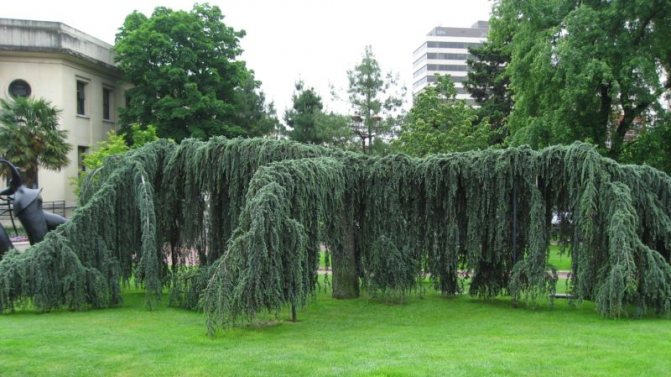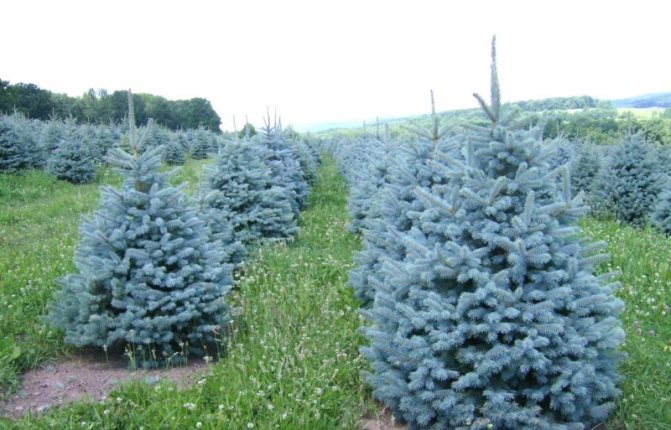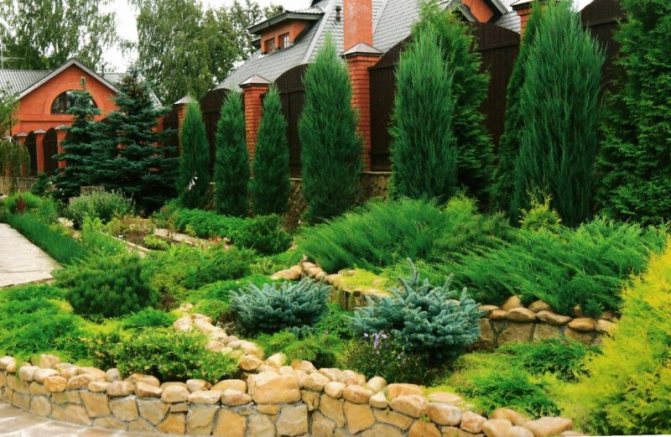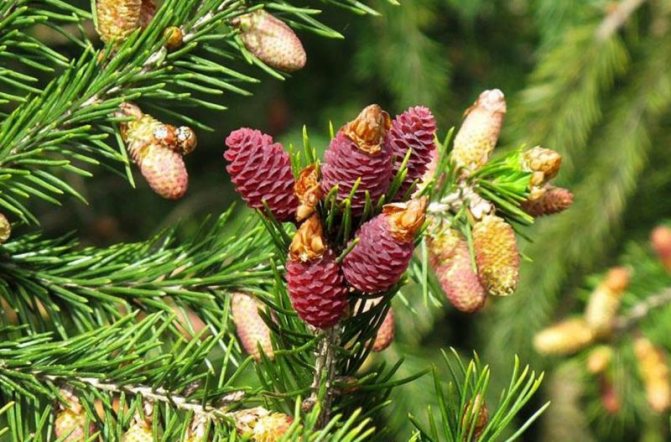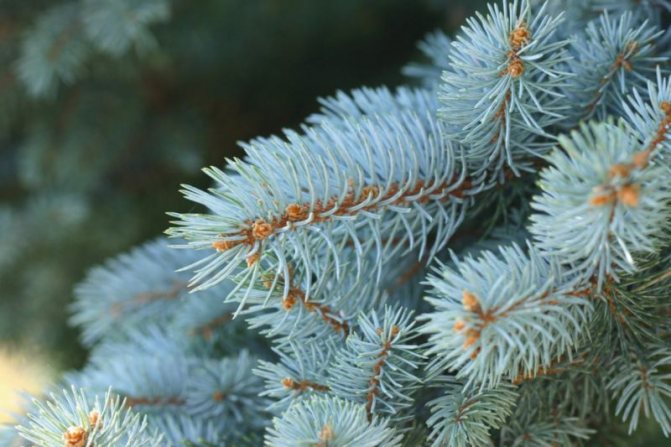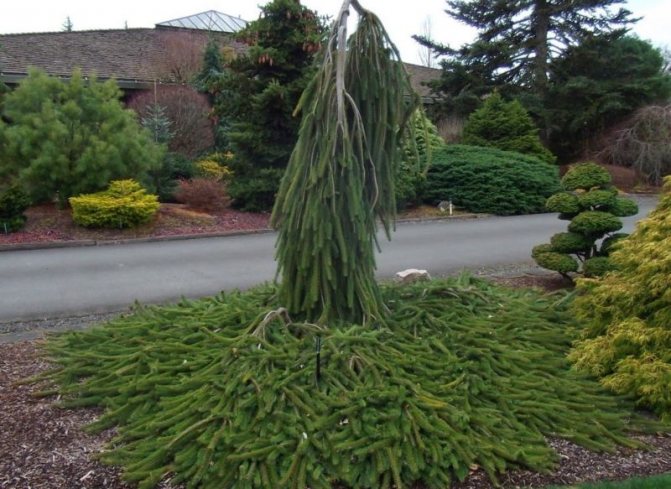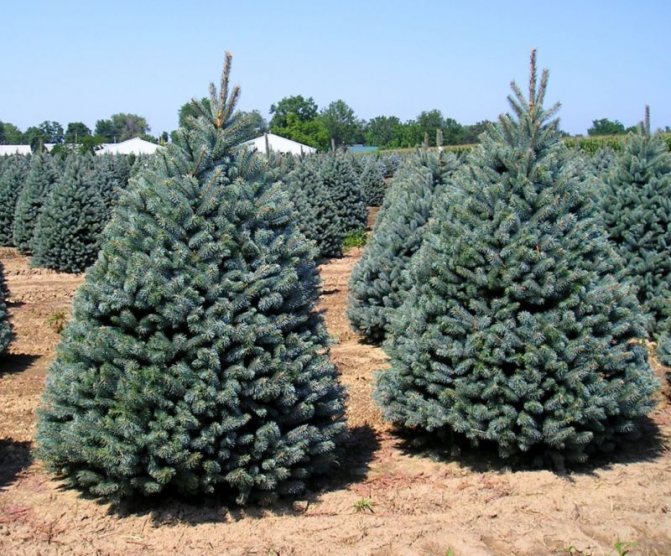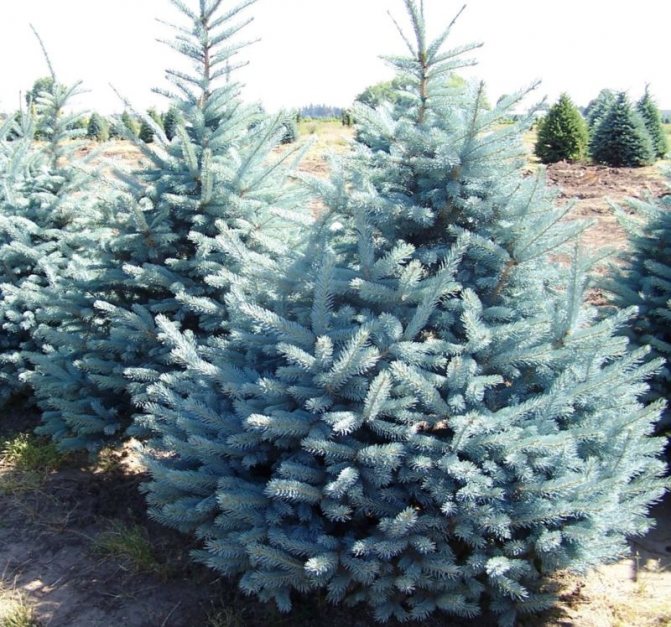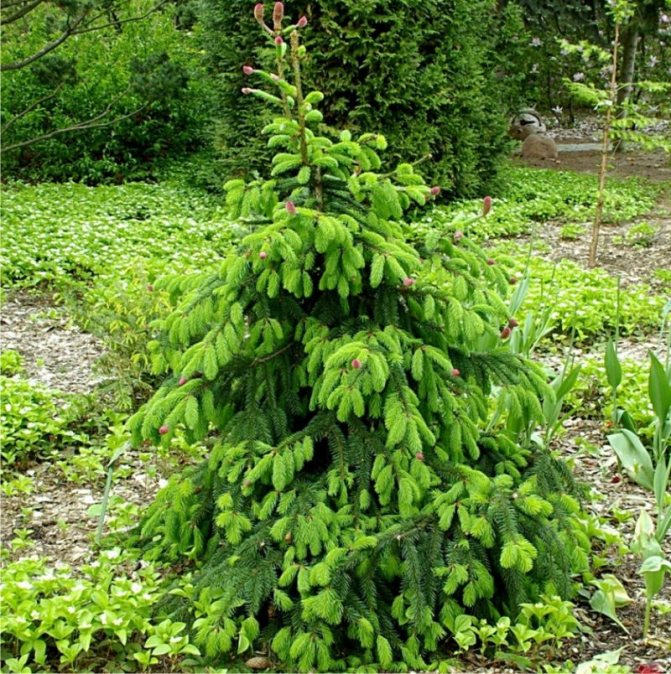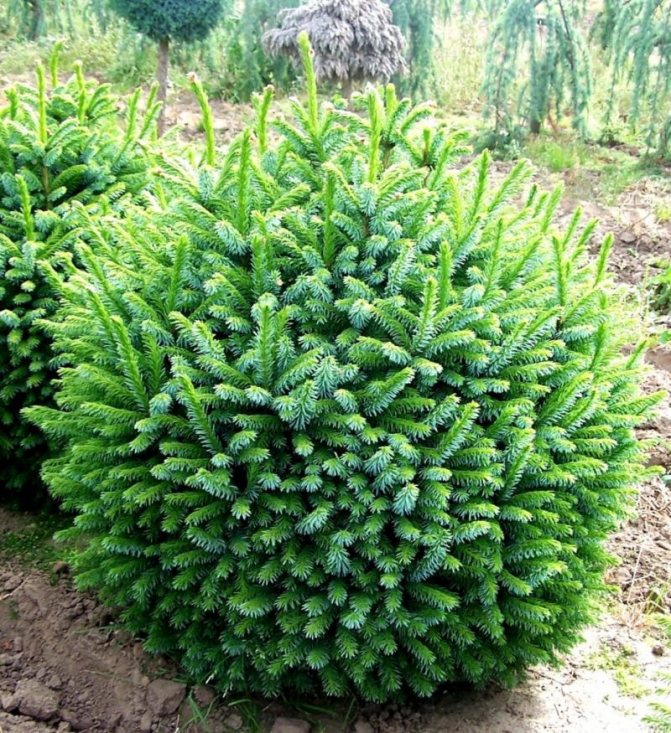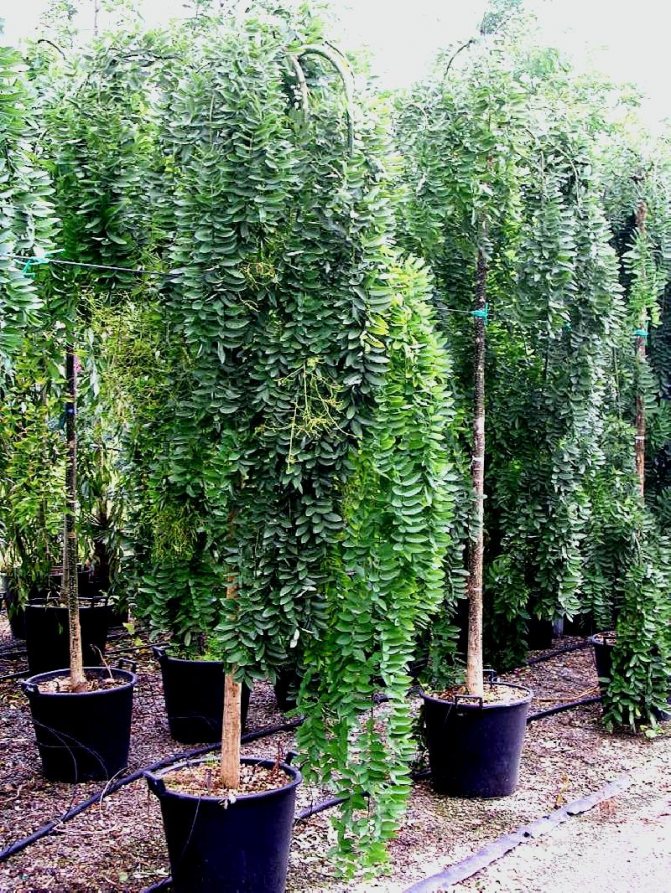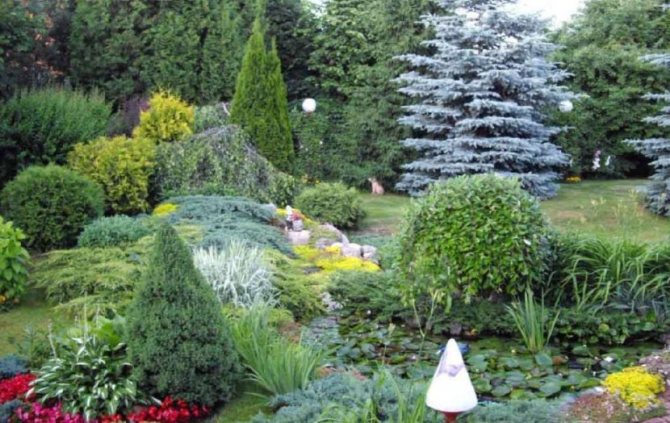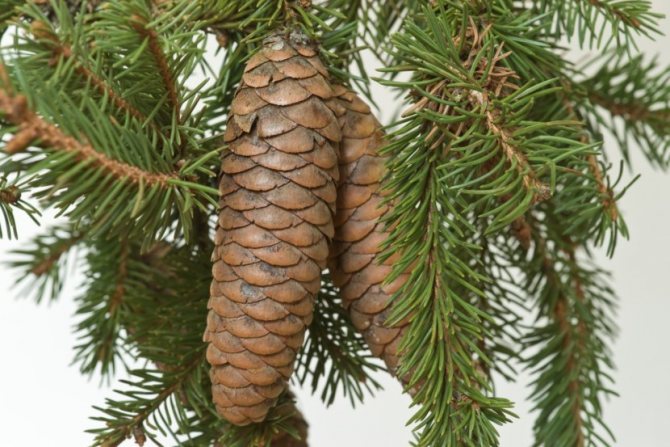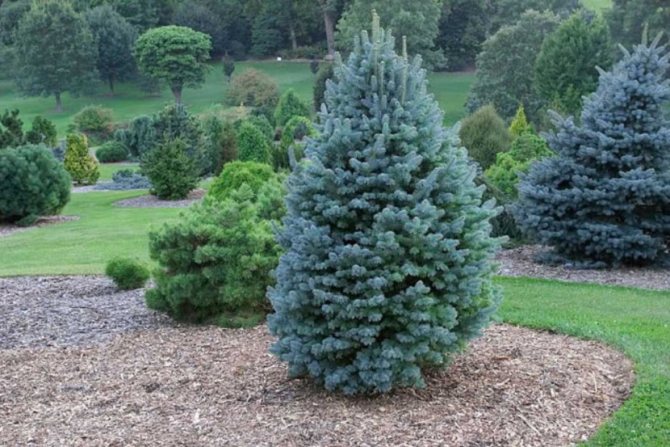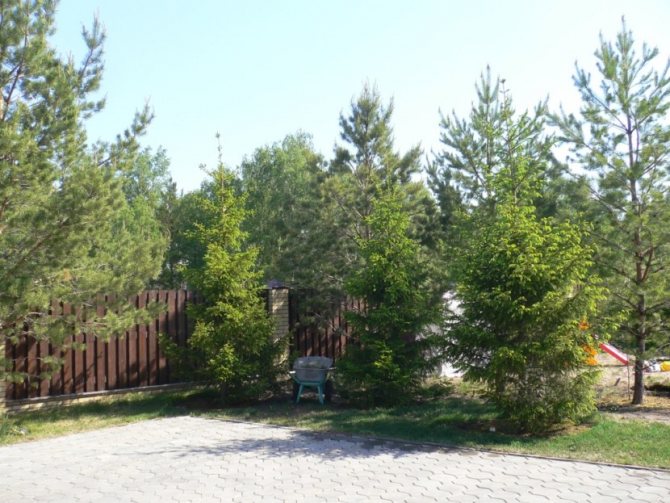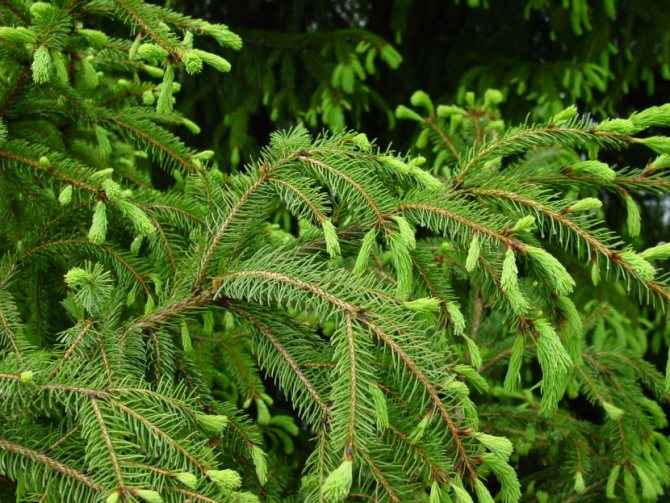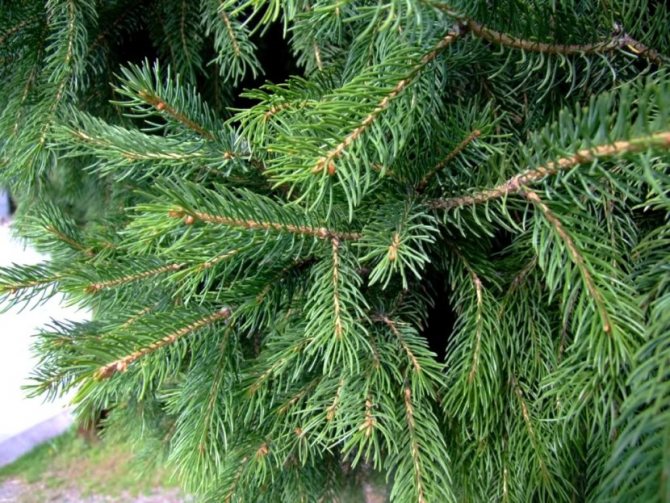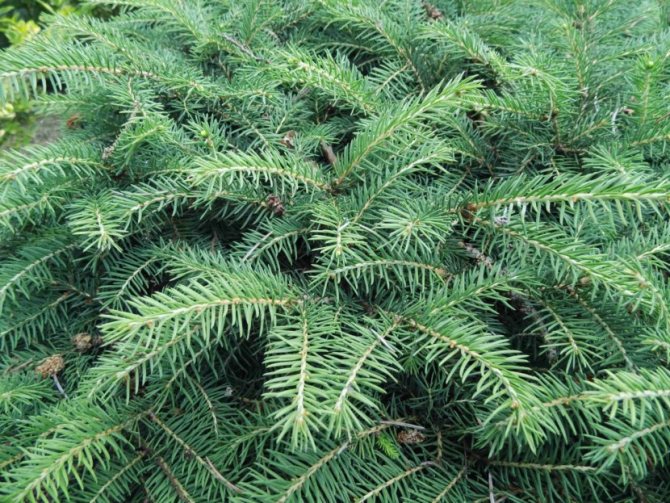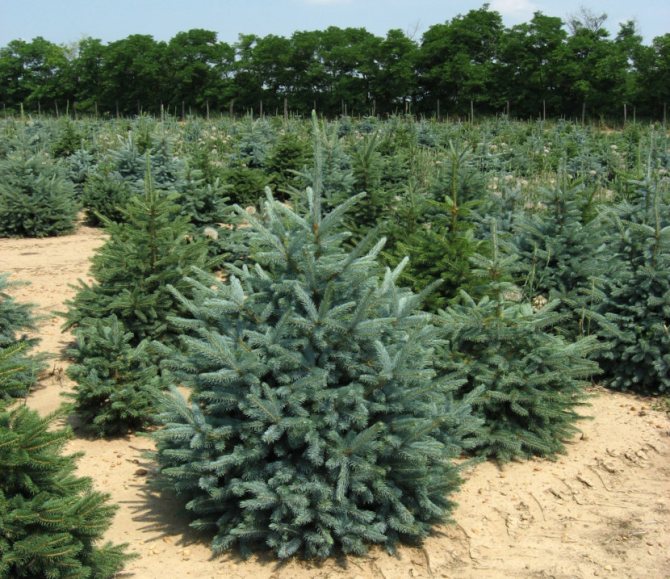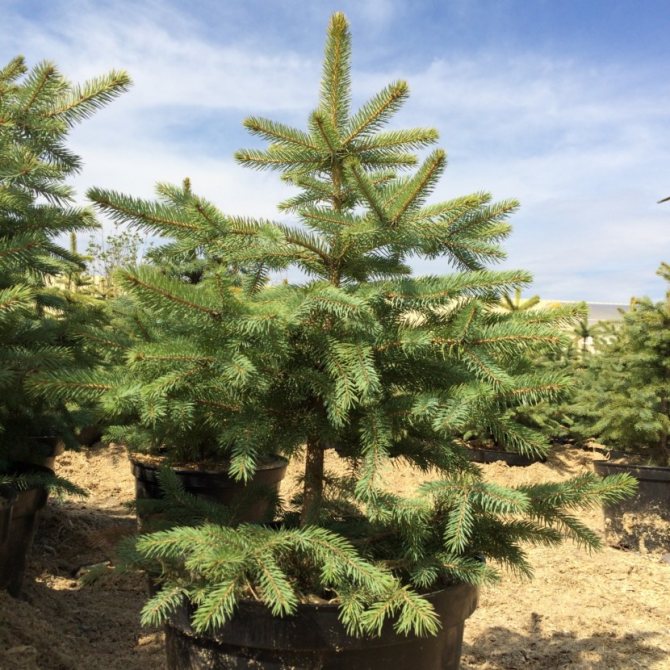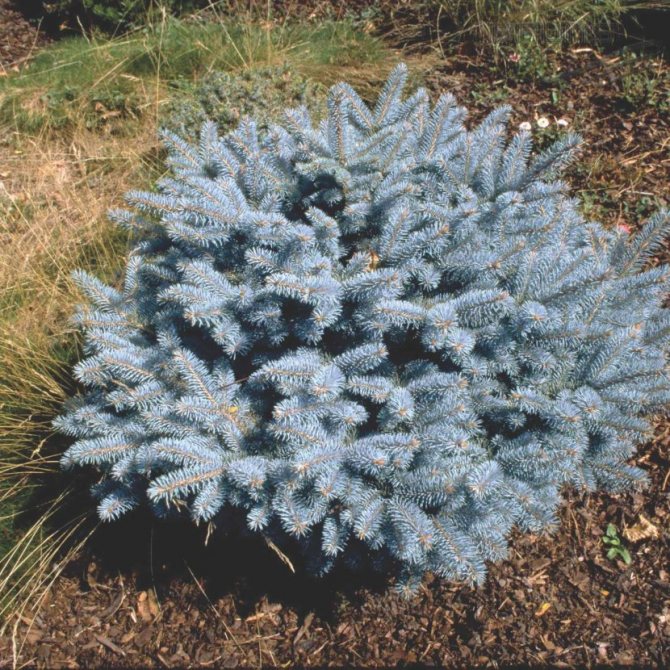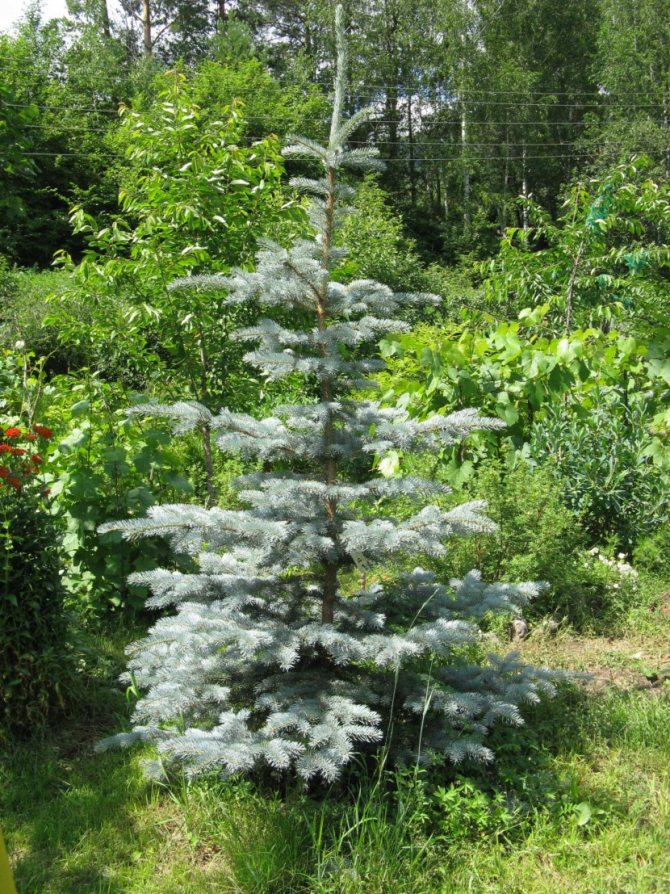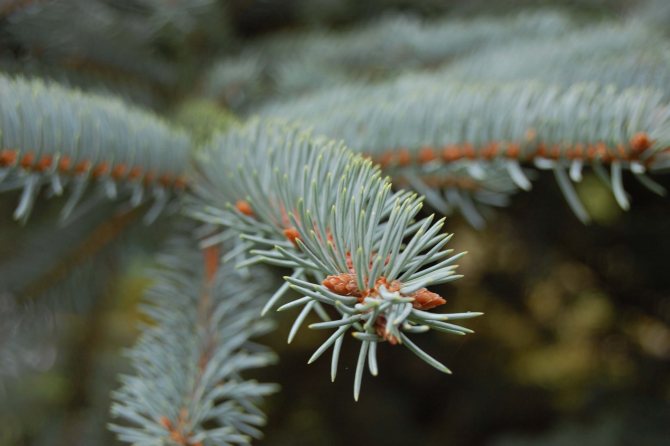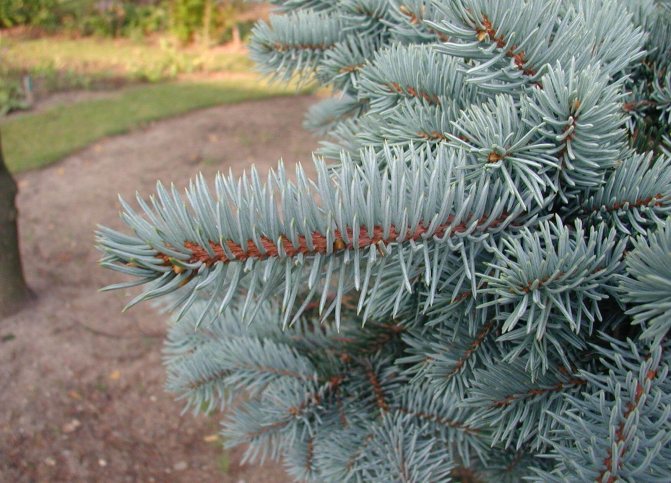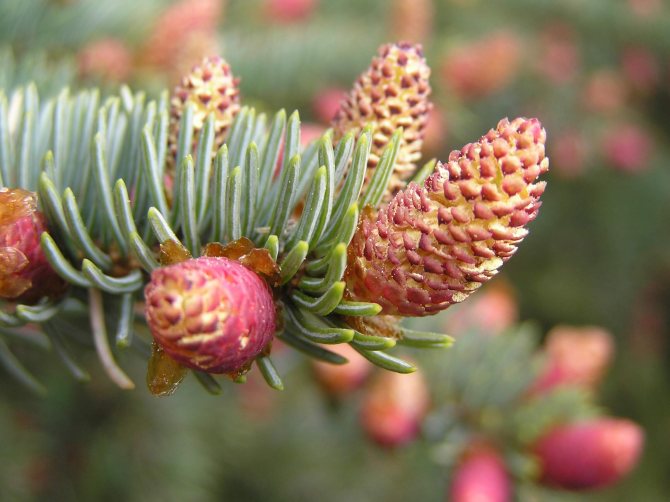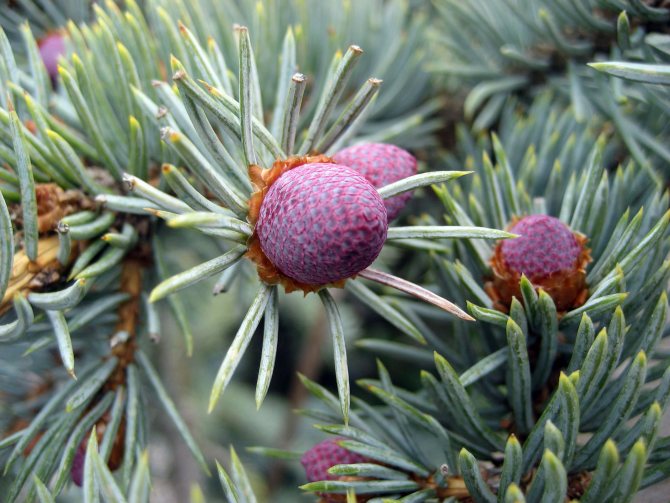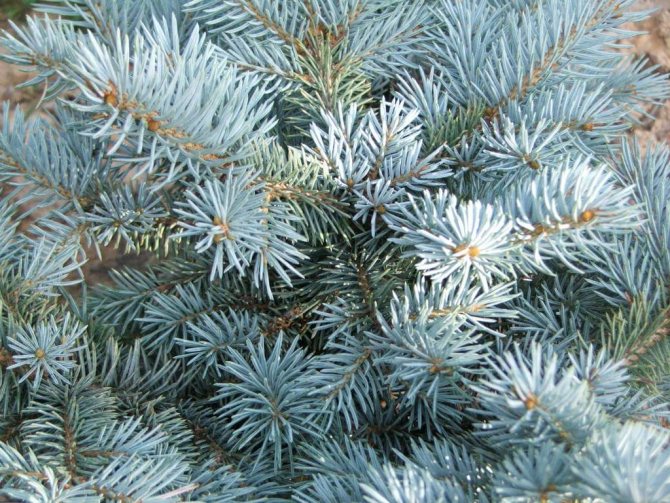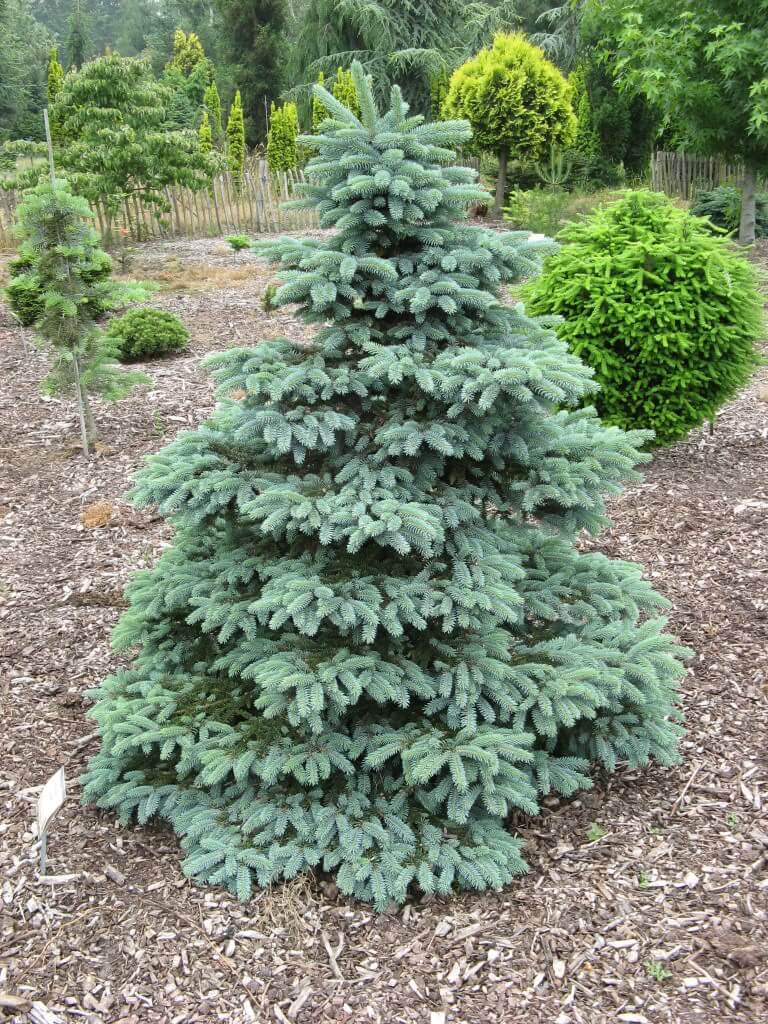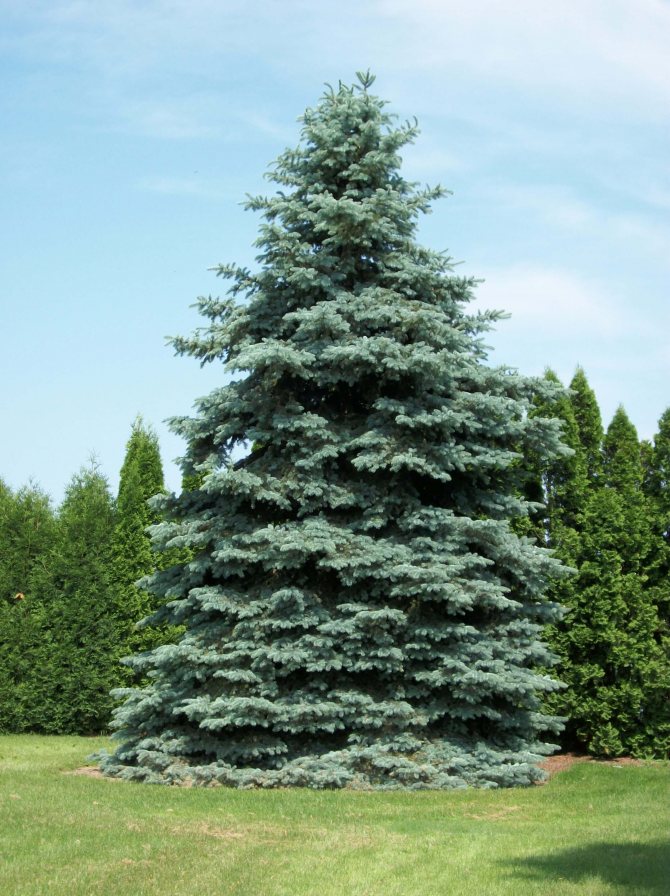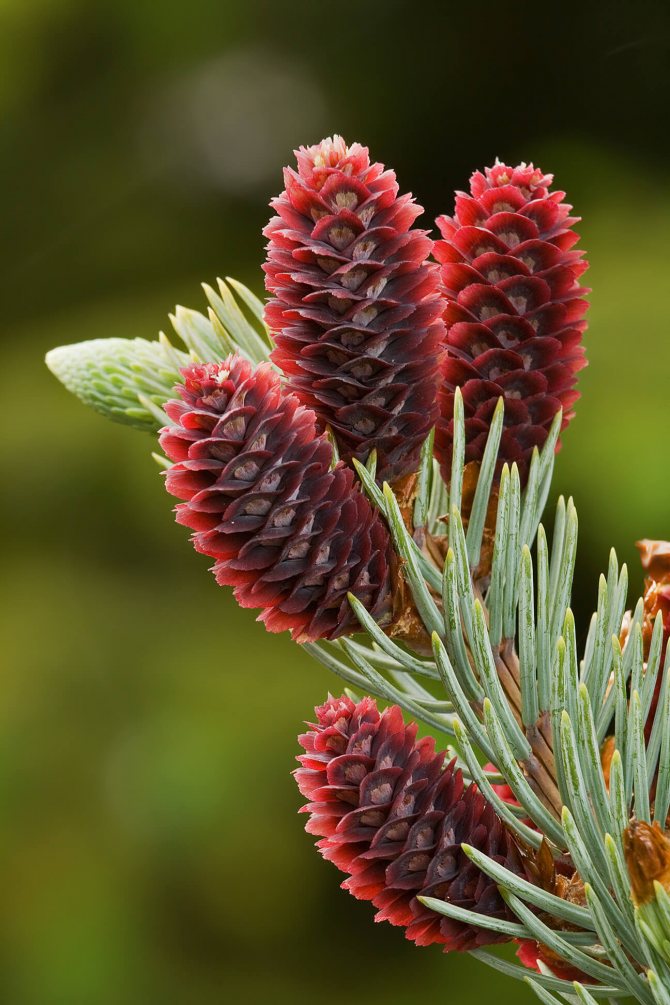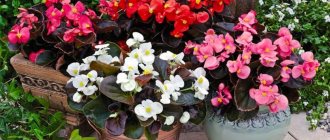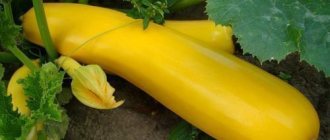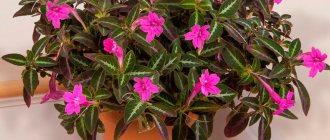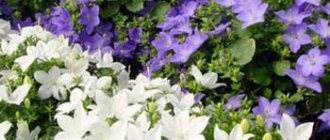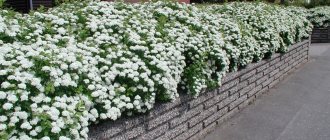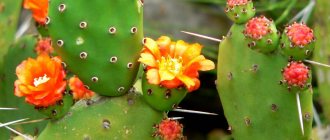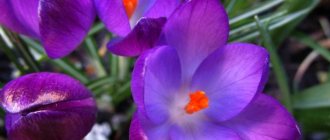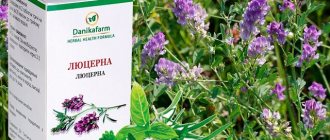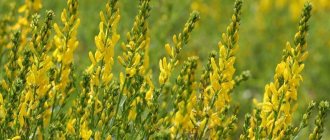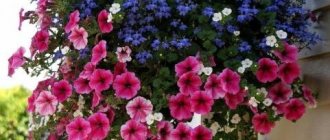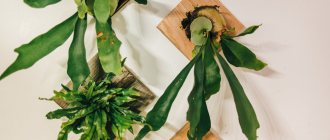Norway spruce is not only an integral part of the New Year, but also an excellent "human shield". It can be used for fencing cottages and summer cottages.
An ordinary spruce hedge will reliably protect your site not only from prying eyes, but also from strong gusts of wind.
And the produced phytoncides are enough to kill airborne harmful microorganisms within a radius of several kilometers.
But, the growth of common spruce in the summer cottage will need to be regularly monitored - cut, shape the crown, otherwise the trees will quickly grow and "crush" deciduous plants.
What types of spruce are there?
European spruce does not grow in urban areas, because trees quickly die from air pollution.
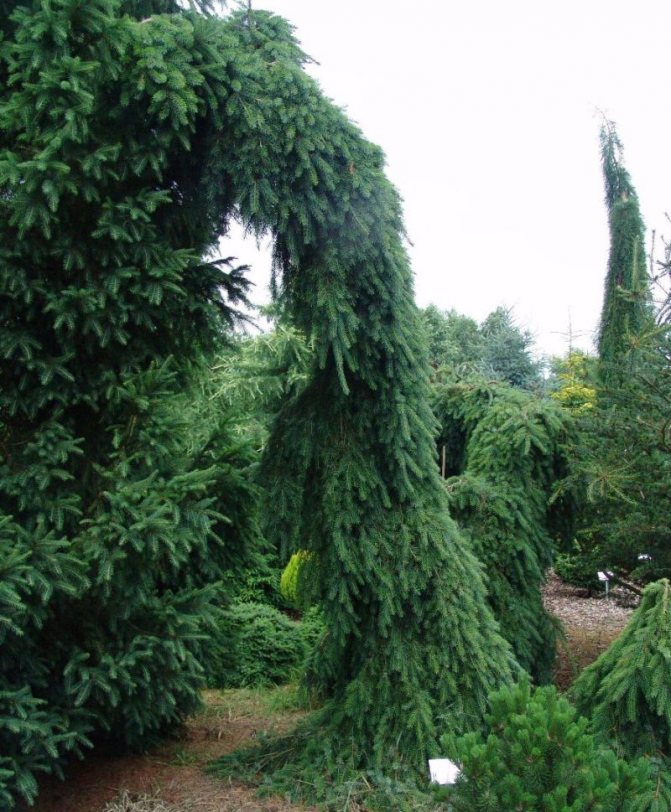
In its natural environment, this tree changes, and therefore several varieties of spruce have been bred. The difference between the varieties is in size, as well as in how the branches are located, which crown and what color of the needles.
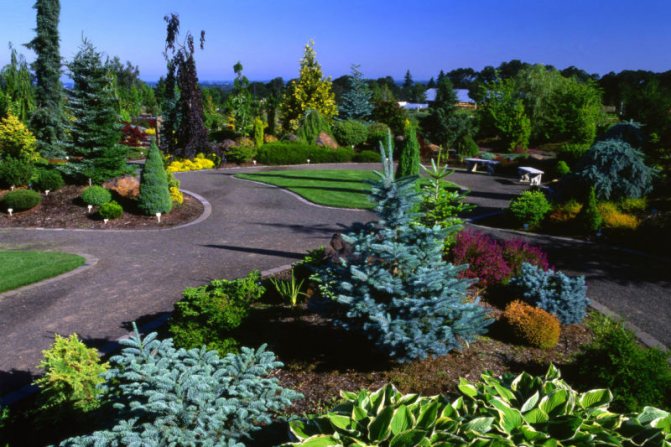

Recommended species and varieties
Abies (E. common, E. European)
This species is our traditional Christmas tree. A straight tree with a conical crown: a high central shoot and lower branches dropping to the ground. The needles are prickly, glossy, dark green, tetrahedral, 2 cm long. Young cones are dense red. Female cones, as they mature, become green with a lilac blush, and after a year - light brown, elongated, hanging, up to 15 cm long. The bark is smooth, reddish brown. The height and diameter of the plant is 6x3 m (20 years). The maximum height is 50 m.
Akrokona
This spruce grows in a bush, in a cone. Spruce, depending on the conditions in which it grows, can be of different sizes and also shapes, growing in length / width to about 4 m. For a decade, the tree "sits" in the same dimensions - within 1.5 m in width and height. New needles are bright green in color, and then acquire a darker color.
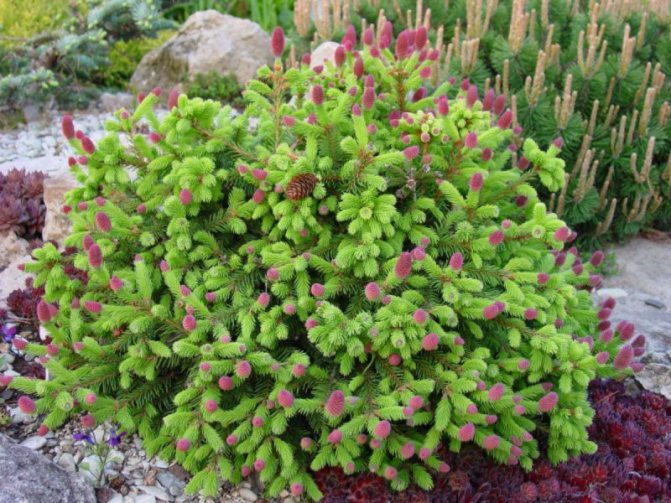

A special decoration of this spruce is a huge amount of cones, which are painted in a maroon shade in spring.
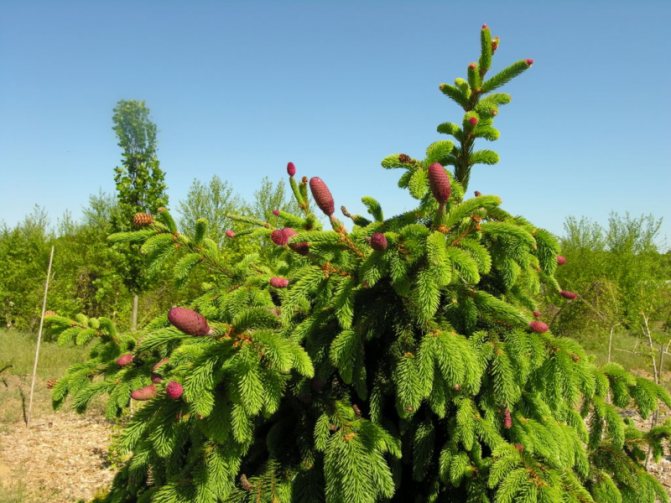

Norway spruce: planting and care
Common spruce seedlings successfully take root on almost any type of soil, it is not unpretentious to the climate and can grow both in the Far North and in the subtropical zone.
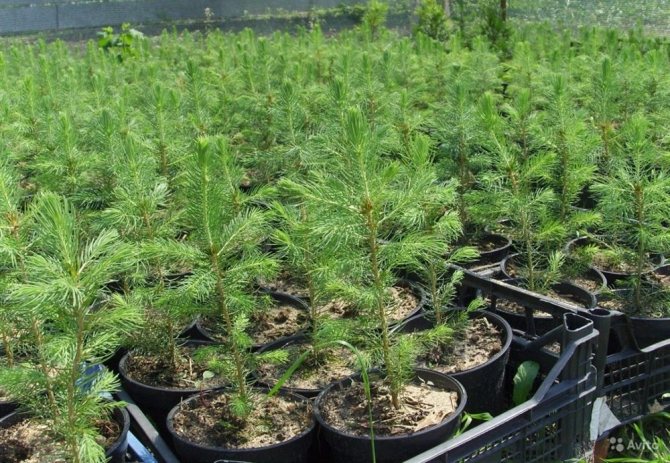

Reproduction:
- Spruce in the wild propagates exclusively by seeds... Thanks to the blades, the seeds of ordinary spruce fly away tens, or even hundreds of meters from the mother tree.
- Garden forms are propagated by cuttings or grafting, only with vegetative propagation it is possible to preserve all the varietal characteristics of the plant.
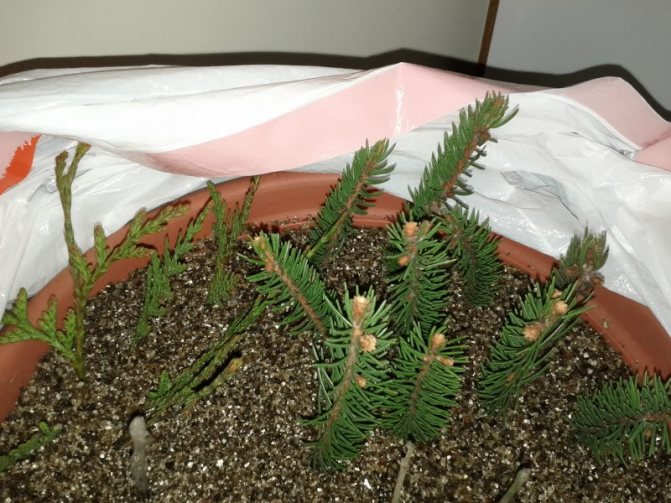

Planting recommendations:
- Although the plant is hardy to the shade, nevertheless we recommend planting an ordinary spruce in an open area with good lighting.
- In the first years of life, the plant grows extremely slowly, does not like regular transplants, the presence of groundwater at a shallow depth.
- Do not plant trees in late autumn or early spring. - young trees are extremely sensitive to frost. It is advisable to cover many decorative forms at an early age in a greenhouse.
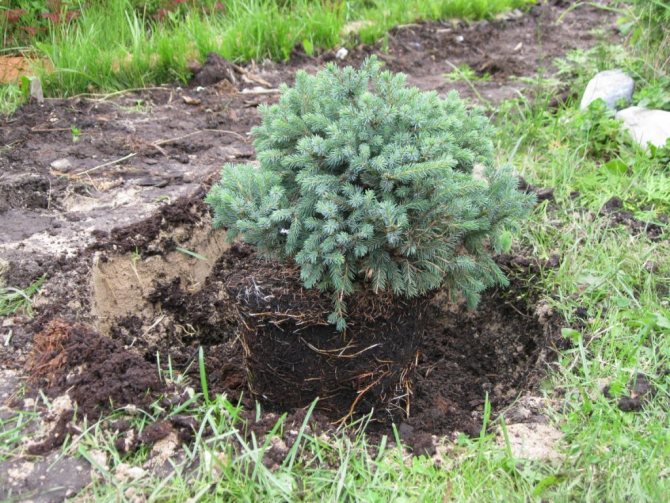

- Loose clay and sandy soils - ideal for planting spruce seedlings.
- Since the plant does not like excessively wet soil, you will need make drainage with a layer of 20 - 25 cm from sand, crushed stone, expanded clay or broken brick.
For planting in a garden or at a summer cottage, an ordinary spruce is not very suitable due to its size and the need for a large amount of nutrients (it will "crush" all the plants around).
Shrub forms with flat crowns - a more suitable option.
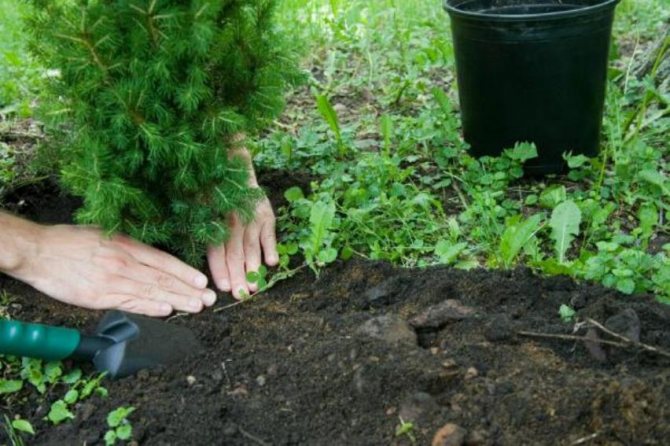

Common spruce hedge
Hedges are very popular in landscape design. The spruce hedge will not only serve as a fence, but also freshen the air in the area, fill the courtyard with a pleasant aroma of pine needles.
If you decide to plant a spruce as a hedge, the distance between trees should not be less than 1 m from each other.
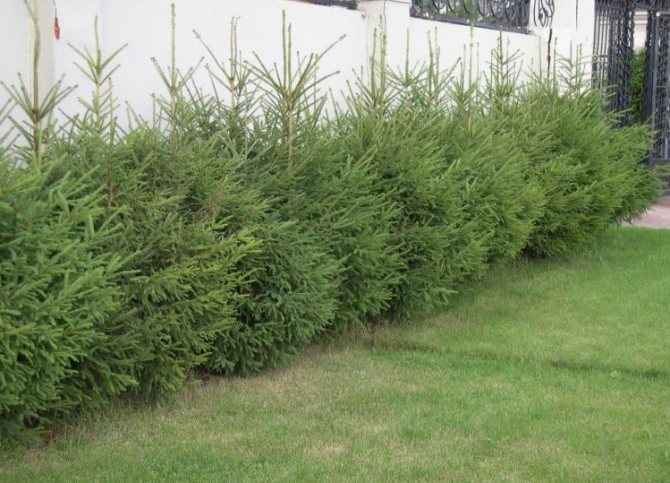

It is advisable to plant spruce on the north side of the site, away from fences, structures and power lines. This will help protect the garden from the wind during the cold season.
Attention! It is not recommended to plant a spruce in the center of the site, its roots spread tens of meters around, and will interfere with the normal development of other plants.
Barry
The general appearance of the spruce is a crown that does not transmit light, which is formed by strong branches growing upward. On the branches there are needles of rich green color and huge buds. Initially, the herringbone is in the shape of a ball, but over time it begins to "stretch", acquiring an oval shape.
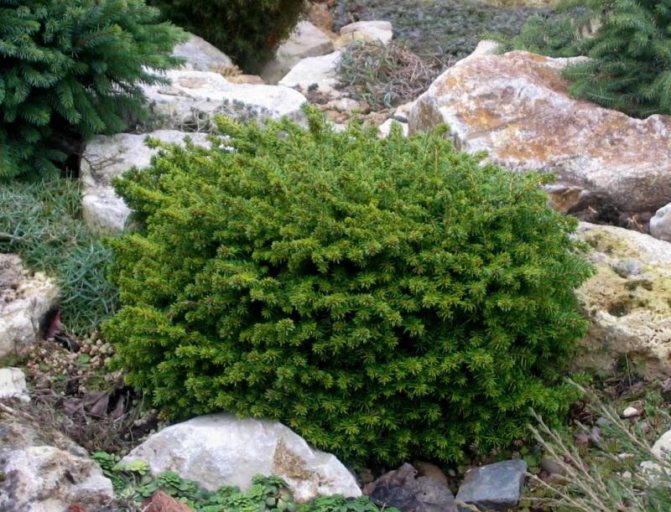

When growing this variety of spruce in the country, it is important to carry out the formation of the crown. Barry is ideal for creating compositions on site.
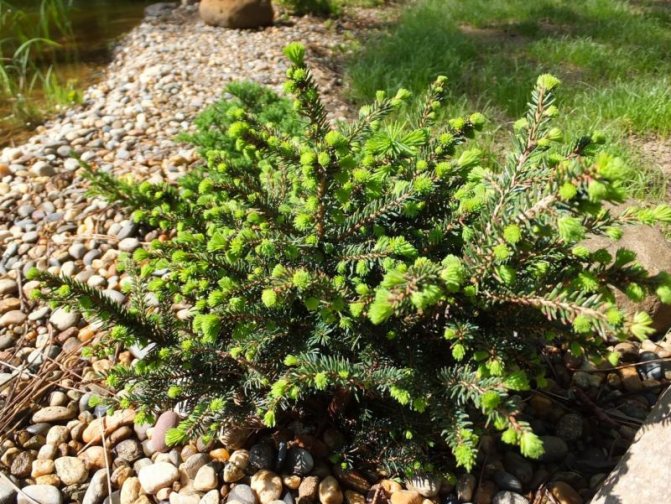

Report No. 2
Spruce - an evergreen slender tree from the pine family, which is easily recognizable by its cone-shaped shape and oblong fruits - cones. In maximum dimensions it exceeds a height of 40 meters. The spruce grows very slowly for the first ten years, then it begins to grow more actively and slows down again after the age of 100 years. She is one of the longest living plants, some species live over 850 years! Young trees have gray bark, smooth. Older plants have rough peeling bark. The length of the needles is up to 3 cm in length, the needles themselves are colored dark green.
In total, the number of varieties of spruce is more than 50 species. Spruce is widespread throughout the northern hemisphere, found in Northern Europe and America, as well as in many cities of Russia.
The northern tree needs certain conditions to grow, such as shade, moisture and moderate temperatures. Due to the fact that these conifers are not sun-loving, young Christmas trees often get burned. Moisture and a temperate climate are of particular importance, since spruce does not tolerate dry seasons and high temperatures, which affects their growth.
These conifers reproduce by seeds that germinate easily. The cones open in early December, the seeds fall out and are carried over great distances by the wind. In the spring, the seed sprouts and the life of a new sprout begins.
Spruce plantings can most often be seen in medical and recreational places, since the needles contain special substances that purify the air.
Many different household things are made from these plants. Softwood is used to make paper, silk, and gunpowder.
The buds aren't useless either. Often, the fruits of spruce are used in folk medicine, they contain a considerable amount of essential oils and minerals.
Everyone has ate from childhood with the New Year. For many centuries it has been a symbol of a new period in life. In the old days, because of its evergreen color, spruce was compared with youth and immortality.
The most common and familiar to us plant, it turns out, has a huge number of interesting and useful qualities.
2, 3, 5, 7 grade in biology
Formanek
Formanek, spruce, the appearance of which is slightly stretched. Spruce grows in an unusual plane for us, forming a very dense covering on the ground. For the spruce to grow vertically, during its growth, it is necessary to form the trunk by tying it to the trunk support.
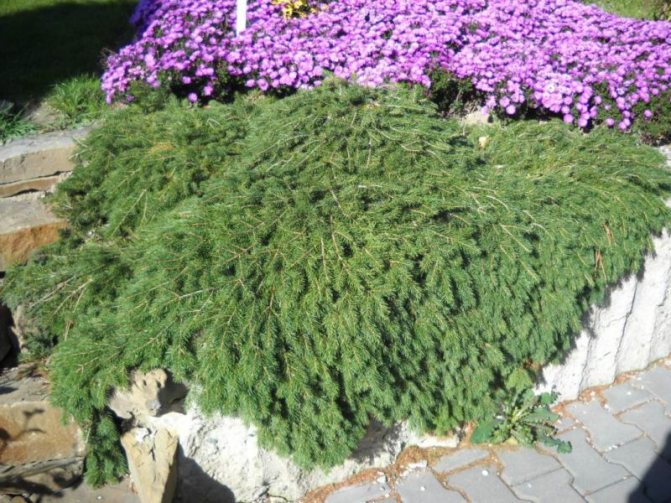

Thus, the spruce will be obtained, as it were, with weeping branches. This type of spruce grows well in pots.
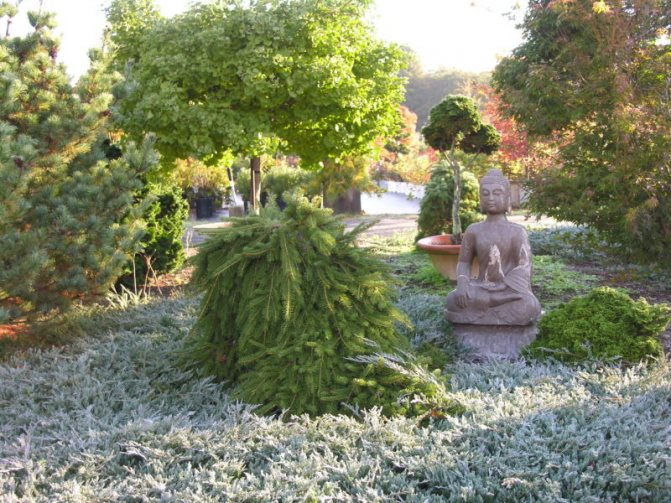

Popular talks
- Report on the topic of the Caucasus Mountains Grade 4
The Caucasus Mountains are one of the most beautiful places on our planet, they arose as a result of the collision of two plates of the Arabian and Eurasian. This is a symbol of those places, the people and mentality that has been formed over a long period of time. - Message-report Great Wall of China 2, 3, 4, 5 grade
The Great Wall of China is a modern wonder of the world. It was built over 2,700 years and is over 8,850 km long. The height of the wall in some areas reaches 9 m, and the width is 6.5 m. The main function of its creation was to protect - Report Lithosphere 5, 6th grade message
The lithosphere (from the Greek words "stone" and "ball") is the solid outer shell of the Earth, formed when magma cools on the planet's surface.
Balkan spruce
This species is the slimmer among all species. The varieties of this spruce cannot be found in nature, because this species is grown in an artificial environment. The crown is in the form of a cone, lowered. In Europe, this spruce is the main attribute of the New Year's celebration.
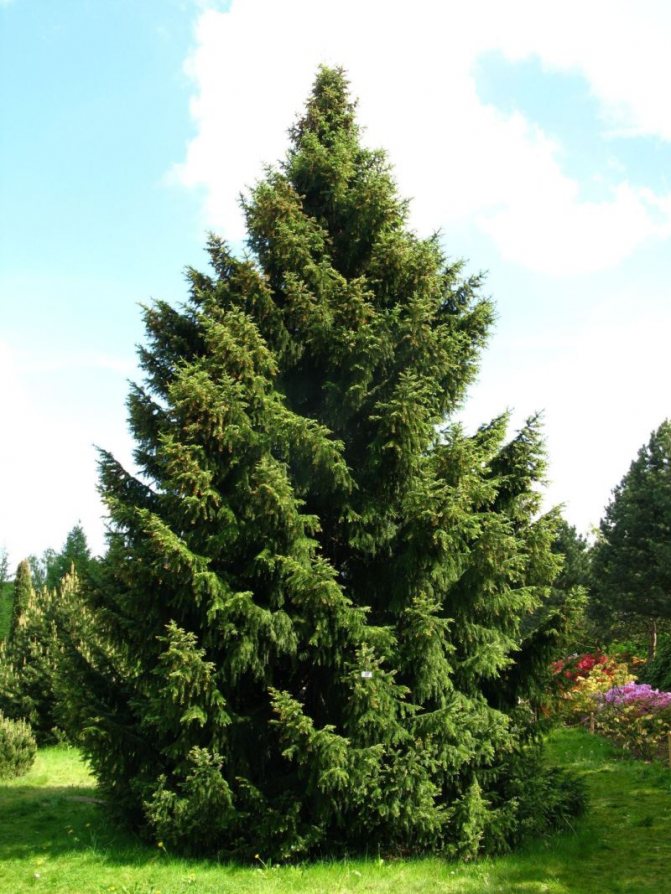

The spruce is light-loving, but it is not found in a single planting, because it can be felled by gusts of wind - the roots lie close to the surface of the earth.
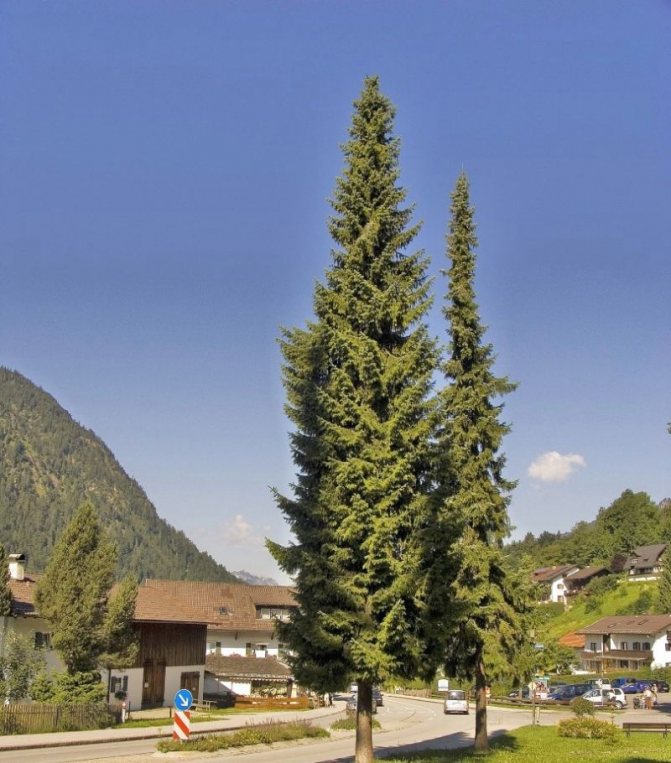

Spruce is not afraid of air pollution, the quality of the soil is not particularly important to it, and therefore this species is in demand in the landscapes of the city. Spruce is easy to trim, and therefore any crown can be created.
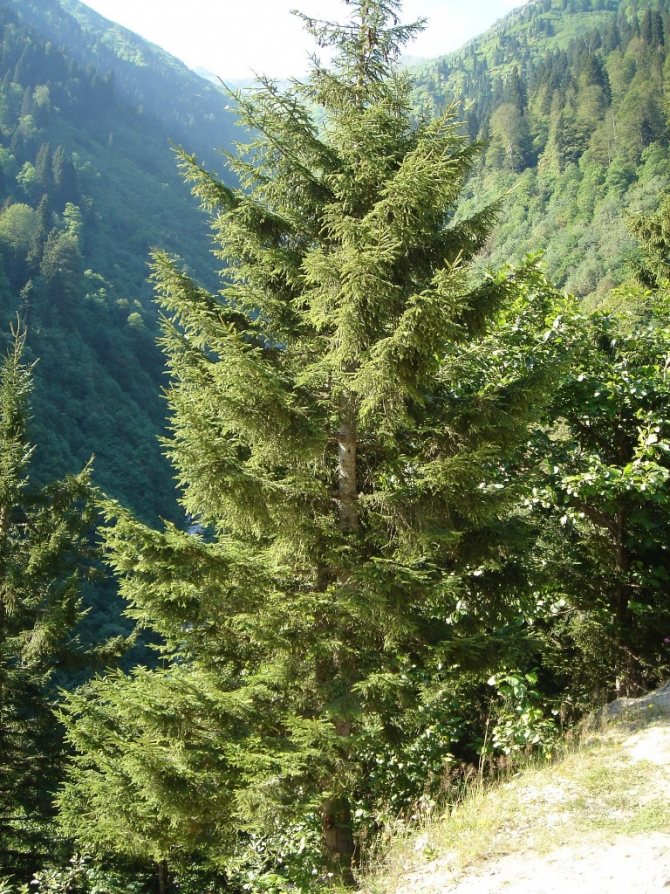

Growing spruce from a branch
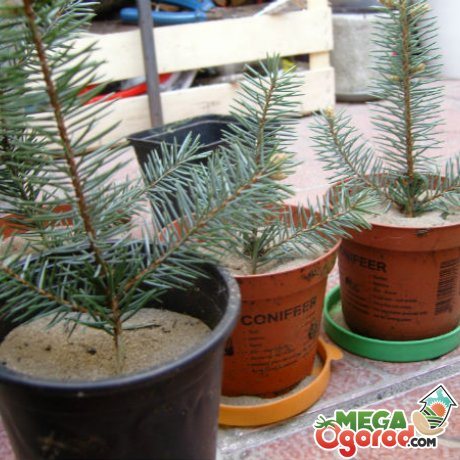

There are many types of spruce, but almost all of them are propagated by cuttings. Therefore, if you are wondering how to grow a spruce from a branch, first find a young and healthy spruce, no older than 8 years old, from which you can take a branch. You need to cut them off from the top of the tree. You only need to take one-year olds. Branches from the middle of the tree also have a chance to take root, but there is a good chance that the tree will grow with a crooked crown.
Tips for growing spruce from a branch:
- Usually the twig takes root only in the second year. But if you want the roots to go already in the year of planting, prepare cuttings in mid-spring.
- The so-called lignified cuttings cut in autumn or winter are stored all winter in a cool, dark place.
- The length of the twig can vary from 10 to 25 cm.
- After the branch is cut, remove all the needles from the bottom by about 3-6 cm and put it in a weak solution of potassium permanganate.
- In order for the stalk to root and take root well, it is necessary to make a greenhouse. It is good if it is heated.
- You can easily make a homemade greenhouse without any help. Drainage must be placed on the bottom to avoid moisture stagnation. Stones, broken brick or large rubble can be used as drainage. After drainage, there is soil and a layer of sand on top, better cleaned. The soil can be taken from the spruce forest or purchased at the store.
- We cover with a film so that there is a distance of no more than 30 cm between the sand and the film.
- At first, we ate a shade, so we put a dark coating on top of the film, you can use burlap.
- You need to plant a twig to the depth to which you cleaned it of needles.
- They are planted at a slight angle with an interval of 2 m (if you are planning an alley).
- Remember that spruce can grow very large, so do not overuse with seedlings.
The first time you need to water abundantly and every day, in the heat up to four times a day. Don't forget to loosen the soil as well. When the first roots appear, you do not need to water more often than once a day. You can spray seedlings with a mineral mixture. For the winter, you need to cover them with sawdust or foliage.
Photo gallery
Spruce varieties and their uses
Like many conifers, spruce is quite decorative. She has always been an adornment of the Russian estate, gardens and parks. Today, thanks to a large selection work, many types of spruce have been bred, used in garden landscape design.A herringbone, personally grown from seeds, will not only decorate the site, but can also become the ancestor of family traditions. This method of growing fir trees from seeds is suitable for all tall species. In addition, such cultivation is a guarantee of excellent adaptation of the seedling to the climatic conditions of the area. Of the existing species, the dwarf spruce attracts special attention of landscape designers. Low-growing varieties usually do not exceed a meter in height, have a wide, dense crown.
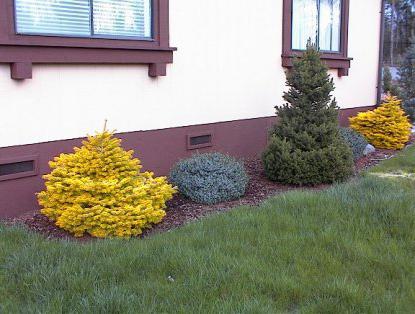

They are great for decorating garden compositions, stone and alpine hills. One of the most spectacular and demanded representatives of such species is the Nidiformis spruce.
Interesting facts about the spruce
- Thanks to the ability of spruces to sprout from the roots of a dead tree, the Swedish National Park is home to the planet's oldest spruce root system, more than 9,500 years old.
- The best musical instruments have long been made from spruce wood: gusli, guitars, cello. Spruce for their creations was used by Amati and Stradivari.
- The spruce forest is the most shady and darkest because of the "shaggy" spruce paws densely covered with needles. Even in the heat, it is always cool in the spruce forest.
- Some peoples of Europe considered the spruce to be a totem tree: the warriors of the ancient Germanic tribes "placated" the spirit living in the crown, decorating the spruce with flowers and uttering ritual incantations before the campaign of conquest.
- Spruce needles are an excellent vitamin remedy that is used to make "green" flour for livestock feed, and wood is sometimes used for tanning leather.
Did you like the article?
Reproduction principle
Spruce is usually propagated using seeds that can be collected under any mother plant. To do this, you just need to cut off a few cones from the culture and place them in a warm place until they are completely dry. Trying to get the seeds or peeling the bud is not recommended, as the buds will open on their own and give the grower ready-made material for planting.
It is best to process the resulting seeds with a special solution of potassium permanganate. Calcined river sand will be the best substrate for planting seeds. This requires place one seed in a container with soil and deepen it a few centimeters... It is important to put the container in the refrigerator or in a cold place in the house (this will be a stratification). It is especially important to carry out this procedure, since in nature the grains of needles are exposed to low temperatures in winter.
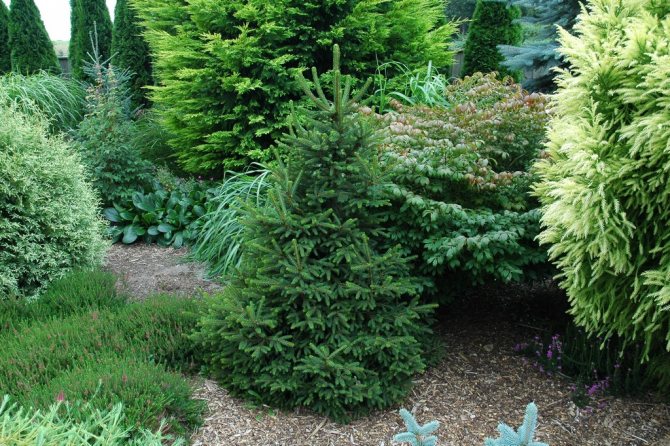

Stratification helps speed up seed germination time. In a cold temperature, the seeds should be kept for three months, this time will help provide the culture with wintering. The planting material that has not undergone stratification can lie in the ground for a long time, but still not sprout. After some time, the container with the seeds inside is placed in a clarified place and wait for the first shoots.
For sowing, it is best to choose October or November, so that the seeds are in the ground just during the winter season. In March, a container with seeds, which was in the refrigerator or on the balcony, will be the best material for germination of seedlings.
How to plant a chestnut correctly: growing seedlings from seeds
Application
Siberian spruce is a slow-growing species and is listed in the Red Book. Felling is rare.
The wood is sapwood, long-grained, almost white in color, with pronounced annual rings, contains little resin, and is relatively soft. It is used in the manufacture of furniture, turning products, finishing materials, paper, cellulose, charcoal, alcohol, acetic acid.
The needles of Siberian spruce contain valuable essential oil used in the pharmaceutical, cosmetic industry, and folk medicine.Biologically active substances have a powerful anti-inflammatory and antiseptic effect, help with diseases of the musculoskeletal system, respiratory system, digestion, skin, mucous membranes.
Siberian spruce is a valuable ornamental plant... It is used to decorate parks, gardens, city streets. Dense needles release phytoncides that cleanse the air from harmful microorganisms. The resinous scent of firs improves mood. Being near trees is useful for people suffering from infectious pathologies, nervous disorders, and a breakdown.


Differences between a Christmas tree and other conifers
The Christmas tree, as one of the representatives of the spruce genus, has many similar characteristics with the rest of the Pine family: fir, pine, cedar, larch.
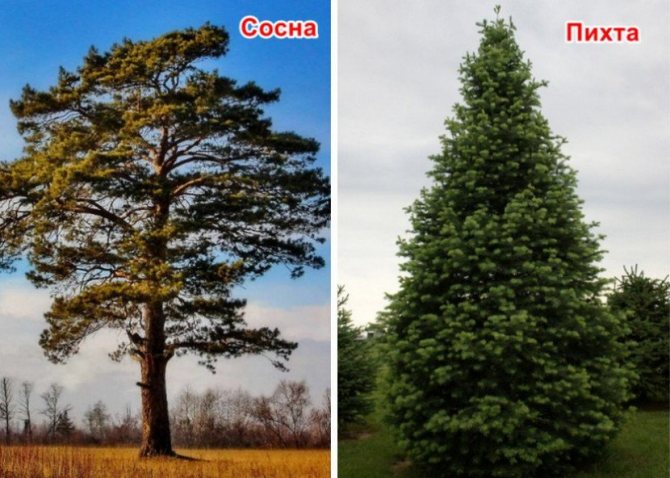

Pine is a light-loving plant that grows poorly and develops in the shade. Spruce, on the contrary, prefers partial shade and dries up during prolonged sultry weather.
And if it is quite difficult to confuse the last two varieties of conifers with a Christmas tree, then with fir and pine the situation is a little different. Below is a comparison of the main differences between these pine plants.
| Christmas tree | Pine | Fir |
| Low growth rate, average height is 30 m. | Normal growth rate, average height 40 m. | Normal growth rate, average height 80 m. |
| Cones are reddish brown, large. | Cones are yellow-brown, medium in size. | Cones are brown, elongated. |
| The needles fall off gradually, completely renewing in 8-12 years. The length of the needles reaches 3 cm. | The needles fall off quickly, completely renewing in 2 years. The length of the needles reaches 6 cm. | The needles fall off gradually, completely renewing in 4 years. The length of the needles reaches 5 cm. |
| The needles are evergreen, tough. | The needles take on a copper-yellow hue closer to autumn, hard. | Evergreen needles, soft to the touch. |
| The average age is 180 years. | The average age is 350 years. | The average age is 150-200 years. |
| The main root atrophies over time, the main load falls on the lateral roots. Because of this, the spruce can collapse during strong winds. | It has a tap root system, but the main load still falls on the main root, due to which the pine is well attached to the soil. | It has a powerful core system with a long main root. |
| The shape of the crown is a regular cone. | The shape of the crown over time from a regular cone is replaced by a spreading canopy with randomly placed branches. | The shape of the crown is pyramidal. |
Thus, the tree is a narrower concept, since it relates to only one type of pine plant, while the spruce covers more than 40 species. This is also related to the difference in the distribution area of conifers. It should also not be forgotten that the tree is just a popular name for the common spruce, and in botany there is no such term.
The healing properties of spruce
- Spruce is considered the oldest medicinal tree in the Russian forest. Even primitive people managed to use it for treatment.
- For therapeutic purposes, pine needles, spruce cones and resin are used.
- Spruce contains amino acids, bactericidal substances, chlorophyll, phytoncides and vitamins.
- Spruce needles contain a lot of ascorbic acid. Vitamin C in this tree is 6 times more than in orange and lemon, and 25 times more than in potatoes and onions. Its greatest concentration is in early spring and winter.
- If you consume 3-4 needles from coniferous trees every day for a month, you will be able to restore the immune system, increasing resistance to viral diseases.
- A few twigs of twigs that are left in the room will help kill harmful bacteria in the room, while leaving a pleasant scent in the air.
- Spruce cones are rich in tannins and essential oils. They also contain manganese, copper, aluminum and iron.
- Spruce kidney syrup is made with a microinfarction.
- A decoction of pine needles is used for inhalation in the treatment of sinusitis and tonsillitis.
- The resin or sap of this tree has antiseptic properties and is used in ointments that heal wounds and ulcers.
- One of the excellent remedies for wounds and cuts on a hike is resin resin. By lubricating wounds, ulcers and cracks with it daily, you can speed up the healing process.
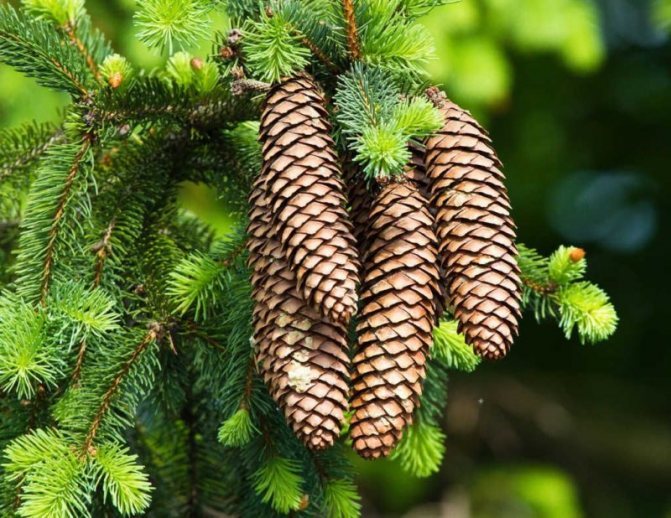

Pests and diseases
Most of the dwarf varieties P. abies and P. glauca var. albertiana is affected by spider mites. Ate also suffer from real honey fungus and various fungal rot of lateral roots and the main root, most often from root rot of conifers (causative agent - Schweinitz tinder fungus -Phaeolus schweinitzii) and brown pit rot (causative agent - tinder fungus root sponge - Fomes annosum, syn. annosum). In the middle lane in recent years, bark beetles have strongly spread, the larvae of which settle under the bark and can cause shedding of needles and the death of a tree. Among the diseases, mention can be made of rust and shute. Some forms in early spring may suffer from pine needles burn.
Features of ordinary spruce
Common spruce grows mainly in Central Europe and in the European regions of Russia; it is the main coniferous crop that forms the taiga.
In the European part of Russia and in the North of Siberia, over time, ordinary spruce is replaced by Siberian. There are no particular differences between these species. Also, pines are not very different from larch and pine. But when growing, spruce is particularly unpretentious, while larch likes to grow in the shade and is difficult to take root in open places. At the shoot stage, pine is damaged by low spring temperatures or sunburn.
It is important to remember without fail that crops are not protected from forest fires that occur through human fault or due to seasonal arson.
Spruce needles are actively used in medicine, as they include a large number of useful components, minerals and other substances:
- essential oils;
- tannins;
- phytoncides;
- resin;
- vitamins K, C, E and PP;
- copper, iron, chromium and manganese;
- bioregulators of natural origin;
- carotenoids.
With the help of tinctures of spruce needles, you can fight a large number of diseases and ailments. The broth helps well with:
- bronchial asthma;
- atherosclerosis and hypertension;
- kidney disease;
- viral lesions of the upper respiratory passages;
- lesions of the epidermis with various fungi;
- plexitis, nervous disorders and sciatica.
Characteristic features of the plant
The description of the spruce is unambiguous: it is one of the fairly unpretentious plants on Earth. It is undemanding to soil fertility, it takes root well on very poor soils. She is not afraid of shady slopes and slight waterlogging of soil cover areas. She is incredibly hardy, and she is not afraid of the harsh continental climate. But most species do not withstand gas pollution and smoke, nevertheless, the tree is used in urban landscaping and is used both in single and in group plantings for park alleys and snow shelters. Dwarf or undersized decorative forms are perfect for decorating the landscape of small personal plots, slides and rock gardens.
Description of culture
Spruce is an evergreen crop with an upright slender trunk and a dense cone-shaped crown. The trunk of the culture is quite difficult to discern as it is hidden under the branches.
Fir trees of different ages are covered with a large number of branches that grow to the very base. The bark of young crops is colored gray-brown or brown, rather smooth to the touch. Old spruce trunks are rough to the touch, the bark is severely cracked in some places, you can distinguish resin stains. The needles of the common spruce are needle-like and continue to survive on the plant for ten years. Under the conditions of growth in the city, the life time of the spruce is no more than five years, and the deterioration of the ecology further shortens the life of the plant.
The needles of a coniferous culture in the section of a tetrahedral type are located singly along the perimeter of the entire spiral of the branch.
Cones are distinguished by high density, have an elongated and cylindrical shape. Cones hang from the branches, and in autumn they ripen and form seeds for further dispersion.
The seeds form special seed scales with special cup-shaped wings. Wings are needed to carry seeds through the wind. Experts have found that one seed can cover a distance of up to 200 meters.
The most common subspecies of spruce on the territory of our country are:
- Acrona;
- Cupressina;
- Cruista;
- Barryi;
- Echiniformis.
Christmas tree, tradition and photo
The beautiful and noble tradition of decorating a Christmas tree for the New Year goes back to antiquity, when people deified nature, worshiped the forest and believed that spirits lived in the trees, on which the future harvest and prosperity depended. In order to win the mercy of powerful spirits, people hung gifts at the end of December on the spruce, a sacred tree that personifies life itself and rebirth. According to legend, the decorated spruce branches drove away evil spirits and evil spirits, and also gave the house well-being for the whole next year.
The fashionable trend of the XX and XXI centuries, an artificial Christmas tree, has not become a worthy alternative to a living tree, and a good imitation will in no way replace a real forest beauty. The plastic Christmas tree is another business industry, and real live Christmas trees for the New Year are the tradition of our ancestors, the true spirit of the New Year and Christmas. Therefore, despite all the convenient innovations, most Russians still want to buy a live Christmas tree for the New Year, and state forestry enterprises and private nurseries take care of the quality of the most important New Year's product.
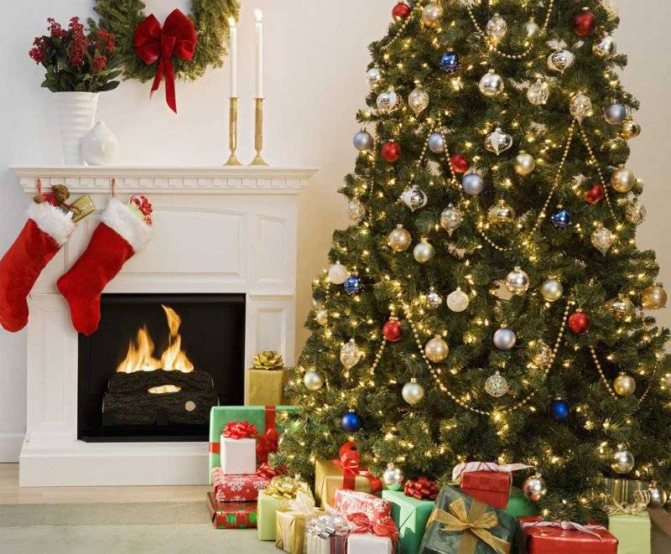

Colorado spruce in the photo
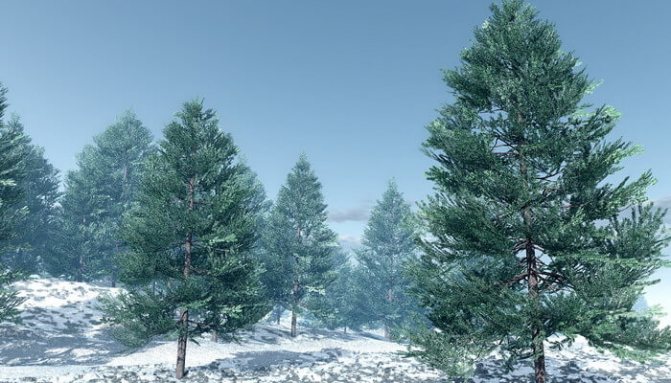

As you can see in the photo, prickly spruce grows mainly in rocky mountains. Most often, these trees can be found in mountain valleys along rivers and streams, in areas with moist soil.
The homeland of the plant is North America. It has been cultivated since the middle of the 19th century.
In our photo gallery below, photos of the prickly spruce are widely presented - one of the most beautiful and common plants of the Pine family. These trees are extremely resistant to urban air pollution and have increased winter hardiness.
Varieties of spruce barbed
More than ten types of varieties of this tree have been recorded in the world. Wild spruce seedlings or those plants that have already sprouted independently on cultivated soils are usually classified as varietal group f. glauca or Glauca vulgaris.
The dwarf tree forms, distinguished by their compact form and low height, and bred by the breeder Ant Kluis in 1937, belong to the Glauca globosa form. Other famous Glauka varieties: pendula, procumbens, prostrata.
Flat-lying Blue Spruce - Misty Blu. It grows only 2 m high. It has a beautiful crown and tough light blue needles. Breeders rank the following relatively new varieties: Filip's Blue Compact (2003), Frieda F. Etzelstorfer (2000), Hermann Naue (dwarf variety of the early 2000s). Many of these trees do well in bad weather conditions, such as severe drought or sudden changes in temperature.
Important! Spruce seeds are stored in special bags all winter under the snow. After the snow layer has melted, they are collected and planted in the ground no earlier than mid-April.

